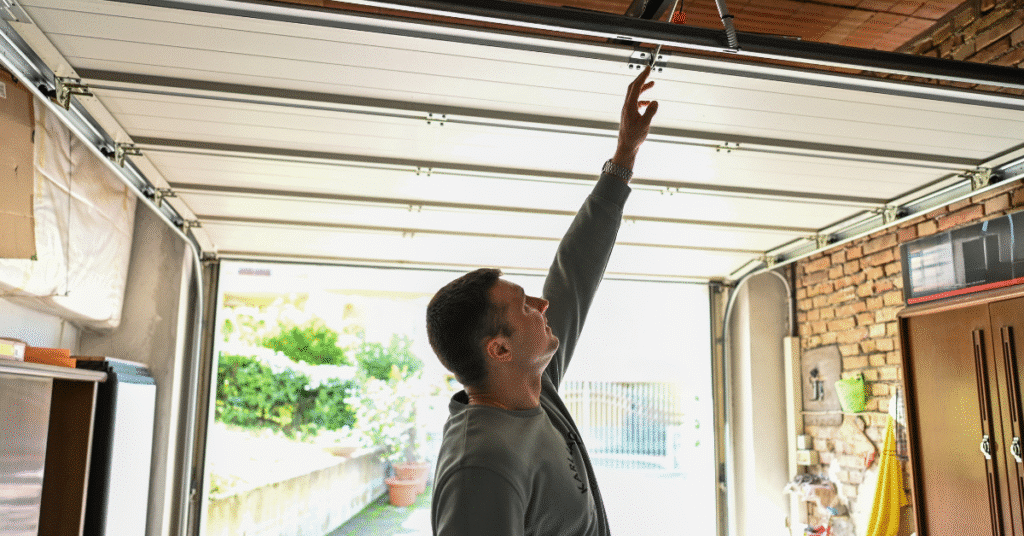
Every garage door system has multiple moving parts that work together for smooth door operation. Learning how to lubricate garage door hardware is the primary maintenance step that avoids premature damage.
Your garage door opens and closes more than 1,500 times a year on average. Each cycle puts stress on the hinges, springs, rollers, and tracks. You should apply lubrication immediately if you hear any noise while opening or closing the door. This will reduce friction between the door parts and help the door move smoothly up, down, or sideways.
You can lubricate the door by yourself by knowing the step-by-step garage door lubrication process and applying the right garage door lubricant. Let’s understand these 7 easy steps.
Disconnect the Power and Ensure Safety
Make your garage door safe to work on before doing anything. Many people skip this step and end up at risk of injury, especially when dealing with moving parts or high-tension springs.
Unplug the opener from the socket or shut off the breaker switch. Close the garage door completely. Use a C-clamp under the bottom roller on both tracks if there is no lock. This prevents the door from moving during maintenance.
Never skip this step. The door can activate unexpectedly and cause injury. Springs and cables are under extreme tension. Stay safe by working with the power off and the door locked down.
Clean the Tracks
Wipe the tracks with a dry microfiber cloth. Remove any dirt, debris, and old residue. Use a damp cloth with mild dish soap to clean grease buildup. Scrub hard spots using a small brush.
Use an old toothbrush for stubborn grime. Never spray lubricant on the tracks. It will make the rollers slide instead of roll. This creates misalignment and jerky movement.
Keep tracks clean but dry. Learn more about mastering the garage door track for smooth operation to avoid alignment issues. Lubrication is only for moving parts, not for the path they travel on.
Lubricate the Rollers
Find all the rollers along the sides of your garage door. Spray lubricant on the metal part of the roller bearing. Do not spray the wheel surface or lubricate nylon if your rollers have no exposed metal core.
Open and close the door manually. This spreads the lubricant evenly through the bearings. Rollers must spin quietly and freely. Replace any roller that drags, sticks, or makes noise. Contact a professional if the rollers are cracked or damaged.
Lubricate the Hinges

Spray lubricant directly on the pivot point of each hinge. This is where the hinge bends as the door panels fold during movement. Only spray the pin inside the hinge and avoid soaking the entire hinge surface. Wipe away extra lubricant using a clean cloth.
Excess fluid attracts dust and debris, which leads to buildup and early wear. Focus on the hinges connected to the curved section of the track. These hinges flex the most during operation and face the highest stress. Without lubrication, they grind against the bolts and metal edges to cause loud squeaks.
Hinges may look simple, but they hold the entire door’s movement together. Replacing damaged hinges requires proper alignment and tension balance.
Lubricate the Springs

Apply a light spray of garage door lubricant to the torsion springs mounted above the door. These are the tightly wound coils attached to the torsion bar. If your system uses extension springs, extend the springs and bearing plates while spraying the full length.
Do not oversaturate. One even coat is enough. After spraying, open and close the door manually once. This spreads the lubricant inside the coils and along the contact points.
Torsion springs store rotational energy to lift the entire weight of the door. That tension makes them dangerous to handle without training. Lubrication keeps the springs flexible.
Dry or rusty springs become stiff. When that happens, the spring resists movement, and the opener works harder. This leads to early motor burnout, worn cables, and total spring failure. Let professionals handle everything else.
Lubricate the Bearing Plates and End Plates

Locate the bearing plates at both ends of the torsion spring shaft above the garage door. These flat, round plates hold the shaft in place and rotate slightly as the door moves. Spray a small amount of lubricant onto the center of each bearing plate.
Also, spray the end bearing plates on either side of the spring tube. These support the bar and carry rotational force during lifting. These plates grind against metal with every use. That grinding sound means friction is already damaging the shaft and bearings.
Lubricating these points reduces noise and extends the life of the torsion shaft. Do not attempt to disassemble or tighten the plates. They hold the torsion spring and shaft in place. Improper handling can destabilize the system.
Contact a professional if the plates are loose, bent, or corroded.
Lubricate the Lock and Arm Bar

Spray a dry graphite lubricant into the garage door lock keyhole. If your door has a manual locking arm, apply a small amount of spray where the bar connects to the door. This joint experiences minor movement during manual operation.
Lubricating the lock mechanism keeps it from rusting up or getting stuck inside. Many homeowners overlook this step until the key refuses to turn. Replacing a lock costs more than maintaining it.
Test the Door Operation
Reconnect the power to your garage door opener. Use the wall button or remote to open and close the door a few times. Observe the motion closely.
Listen for a quiet and smooth glide. Check if the door moves without jerks, hesitation, or banging sounds. The rollers should spin freely. The hinges should flex without creaking. Springs should lift with less strain.
Testing is the final step of how to lubricate garage door parts. If you still hear grinding, rattling, or clicking, one or more parts may need replacement. Manual testing is just as important. Pull the release cord to disengage the opener. Lift the door halfway and let go. A properly balanced and lubricated door will stay in place or slowly settle. A heavy door means unbalanced springs. Do not attempt spring adjustments yourself. This is a high-risk repair for trained professionals only.

Testing completes the lubrication process. Always follow lubrication with a test for safety and function.
Why Regular Garage Door Lubrication Matters
Your garage door moves hundreds of times each month. Without proper lubrication, parts start to wear faster. Hinges squeak, rollers drag, and springs become stiff. Over time, this adds stress to the entire system.
Frequent application of lithium-based grease reduces friction. It keeps all moving parts working smoothly. It prevents rust, lowers noise, and extends the life of your door and opener. Regular garage door maintenance helps you detect small problems with the door.
When You Need a Garage Door Expert
Every homeowner can handle a few lubrication steps by themselves using the right tools. You can lubricate springs, rollers, and clean other moving parts. Call a trained technician if:
- Springs are worn, stretched, or broken
- Rollers are sealed, cracked, or no longer spin
- Hinges or cables are rusted, loose, or damaged
- The door makes loud noises even after lubrication
- Tracks are bent, misaligned, or rubbing
- You see frayed cables or the door feels unbalanced
A garage door technician does more than just oil moving parts. You get a full inspection of every part of your system. They safely handle high-tension parts like springs and cables. Experts have professional-grade lubricants and tools that give long-term performance and fewer emergency repairs.
Letting a professional handle the high-risk parts keeps your system safe and saves you money in the long run.
What Type of Lubricant to Use for the Garage Door
Here are the most reliable, garage-door-safe lubricants for Houston homeowners. These products are tested, weather-resistant, and trusted by garage door professionals.

1. 3-IN-ONE Professional Garage Door Lubricant Spray: This lubricant is specifically designed for garage doors. It is a quick-drying silicone-based spray.
2. Blaster Premium Garage Door Lubricant: This is a silicone-based lubricant with Teflon additive. This lubricant performs well in heat, high-pressure resistance, and won’t drip.
3. WD-40 Specialist White Lithium Grease Spray: It’s part of WD-40’s “Specialist” line and is made for high-friction, metal-to-metal contact. It’s thick, long-lasting, and safe to use on garage door springs, metal rollers, and bearing plates. Learn more on WD-40’s official site.
Avoid WD-40 original formula or any multi-use sprays. They clean, but they don’t protect.
Recommended Lubrication Frequency
Apply lubrication every 3–4 months in Houston. The climate speeds up wear, so seasonal checks make a difference. Always clean before applying a fresh coat, and store your spray in a cool, dry space to protect its pressure and formula. Knowing how to lubricate garage door parts in the right frequency keeps everything functioning.
Final Words
Garage door lubrication is not optional. It is the most important maintenance step for preventing failure. A dry roller or hinge can double the strain on your opener motor.
A dry spring can snap without warning. One skipped lubrication cycle can lead to costly repairs or a full door replacement.
Homeowners in Houston face faster wear because of heat, dust, and humidity. Knowing how to lubricate garage door and proper care increases its lifespan. Never attempt these tasks without proper training. A trained garage door technician can spot hidden wear before it becomes dangerous.
If your door is still noisy after lubrication, consider scheduling our garage door lubrication services. We provide complete lubrication, inspection, and safety tune-ups across Houston. We use top-rated lubricants designed for Houston’s extreme weather.








